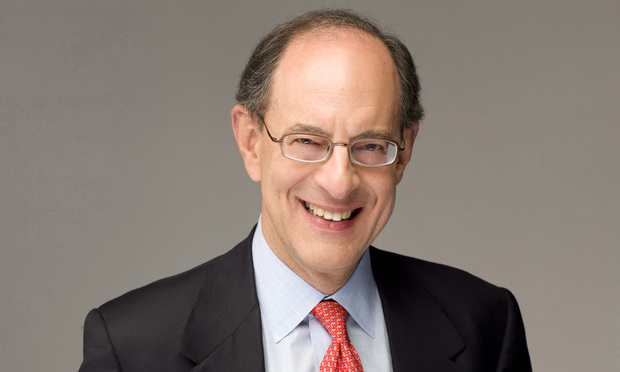Racing Against the Clock: Firms Must Move Fast to Rebuild After Defections
When defections happen, a firm must find a way to show it can still attract and retain talent, whether that involves communication alone, or a quickly executed hire. The alternative could be fatal.
January 28, 2018 at 06:00 PM
12 minute read
 Bradford Malt of Ropes & Gray
Bradford Malt of Ropes & Gray
When a firm gets word that a key partner or group is about to leave, suddenly the clock is ticking.
The firm must decide whether the type of work that the exiting lawyers do is crucial to its bottom line, requiring a replacement, as Proskauer Rose did in 2016 with its Los Angeles litigation practice. Doing so quickly might mean looking for leaders in a smaller firm's practice, which Proskauer did, hiring from Munger Tolles & Olson, or as Buchanan Ingersoll & Rooney did, when it refilled its labor and employment practice with recruits from a midsize Philadelphia firm.
But perhaps the departure was planned, like a retirement or an in-house move, or a strategic shift, as Ropes & Gray demonstrated last year with its patent prosecution spin-off. In that case, the first order of business is reassuring other practices and potential future recruits that the firm is not in any trouble.
In either situation, recruiters and firm leaders say, the firm must find a way to show that it can still attract and retain talent, whether that involves communication alone, or a quickly executed hire. The alternative could be fatal.
“A firm can have maybe a series of individuals or groups leave and may have very valid explanations for why it's not a loss,” says recruiter Frank D'Amore of Attorney Career Catalysts in Philadelphia. “But if it happens enough, it almost doesn't matter, because the perception out in the market is that the firm is reeling. It starts to snowball.”
When any law firm loses a key partner, its public response generally follows a formula, says recruiter Sabina Lippman, co-founder of Lippman Jungers. The firm will say that the practice that lost the lawyer is still strong, she says, but industry watchers will try to read between the lines, often assuming that a lawyer doesn't leave for a more profitable firm if they're not taking business with them.
“It's positive to have the messaging out there to the press,” Lippman says. But, she adds, “what's more important is the message in the market later, about what are we going to do.”
Keep Calm and Send the Right Message
After a departure of a good, lucrative partner or group, internal communication is paramount, D'Amore says.
“With some of these law firms that have gone under, with a lot of them what happens is a series of departures. The people who are left behind get really concerned about the future of the firm … and you start to see other people peel off,” D'Amore says.
It's a familiar pattern. Now-vanished firms like Bingham McCutchen, Dickstein Shapiro and Wolf Block were whittled away by departures, until they could no longer stand on their own. Just last year, San Francisco-based Sedgwick saw one group after another break off, beginning early in the year, until the firm announced in the fall that it would dissolve come 2018.
Firms can control the message most successfully when they're losing a lawyer to retirement or an in-house position, Lippman says. “It's a little bit harder where it's a negative story where there's a departure and there's no good reason for it.”
Aside from its March decision to spin-off its patent prosecution practice of more than 100 lawyers and staff, Ropes & Gray suffered 22 partner departures from January to September of 2017. They included a multi-continent investigations and enforcement group and London funds partner Anand Damodaran, all of whom went to Kirkland & Ellis, and a four-partner team in Hong Kong that went to Gibson, Dunn & Crutcher.
Firm leadership chose to communicate publicly about the changes. The firm admitted that some of the departures were unfortunate, while others, like those in the IP practice, were not moves that Ropes & Gray should shed tears over.
“We have a pretty strong interest with our partners and with the market in being as transparent and candid as we can be,” managing partner David Chapin says.
Particularly with regard to the Asia departures, Chapin and Ropes & Gray chairman R. Bradford Malt say, firm leaders wanted to make clear internally and in the market that the firm remained strong in Asia, and wasn't getting cold feet about its expansion there.
How to move on after departures depends on the situation, Chapin says, but Ropes & Gray hasn't gone on any major campaign to directly replace its recently departed partners. In almost all of the recent cases, he says, partners who left were part of a larger practice that was able to stay the course without additional lateral hiring.
And in some cases, Malt says, departures create opportunity to move in a different direction with future hires, even if it does not instantly look for replacements. For instance, in Asia, he says, “the departures allowed us to get to a place where [our] Asia [group] is moving to strategically … with more lawyers who are bilingual and bicultural.” The remaining partners fit that criteria, he says, so the firm can make that a prerequisite for its future lateral hires in Asia.
A departure that ends up being strategic is easier to talk about during the lateral hiring process with potential new partners, Chapin says. Potential recruits always ask about recent departures, he says, and he responds by describing the firm's greater strategy and financial performance. He can generally explain its rationale in a 15 to 20-minute conversation, he says, quelling any concerns.
Malt says he approaches the conversation by focusing on “the affirmative.” The partner or recruiter contacting the potential hire should be armed with information about the departure and why it happened, he says, but the discussion should be more focused on the opportunity that departure created, and how the recruit would be integral to the practice's strategy.
But in the public, the strategy may be different. For instance, Chapin says, Ropes & Gray talked openly about its decision to spin off its patent prosecution business in 2017, but it was less forthcoming about rightsizing the intellectual property litigation practice.
“It's always tricky. You're talking about individuals who for some reason or another ended up not being a great fit at Ropes & Gray,” Chapin says.
Lateral movement is simply part of the business in Big Law, says David Laurent of Buchanan Ingersoll & Rooney, “and the firm just moves on.” Still, he acknowledged, client outreach is essential to keep a group departure from devastating a practice.
In May, he says, his practice immediately reached out to the corporate practices who had overlapping clients with a group of labor and employment partners leaving for Cozen O'Connor. Senior partners got in touch with those clients and met with them to talk about keeping Buchanan Ingersoll on their roster, he says.
“In a big firm where you have clients with multiple touch points, you have to do the best you can to keep those touchpoints,” Laurent says. “You have to move reasonably quickly and reassure your client that we're still able to do the work, and we have the horses to do it.”
People tend not to follow departures at a micro-level, but they do notice patterns, D'Amore says, so it's important to show the market and internally that the firm is still attracting new people, despite departures.
“If you start to not see a firm in the news all that much with respect to their recruiting efforts, and when it is in the news it's because they're losing people, it does have an impact,” he says.
Making the Next Hire
After getting the right message out, a firm needs to decide what it wants, D'Amore says. And if that involves replacing a partner or group, it must “proactively recruit.” The firm may have to “stretch a little bit” in order to backfill the vacancies, perhaps offering more compensation than it normally would or loosening parameters on billing rates, he says.
“It usually takes relatively quick action, or at least dedication to it,” D'Amore says. “The longer time goes by and things are quiet, usually the worse it is.”
The process will likely require the assistance of an “obnoxious, aggressive, somewhat likeable recruiter,” Lippman says, who can convince the recruit that the firm still has worthwhile opportunities, despite recent exits. If a firm relies on its lawyers to replace a partner, she says, it might not get done quickly enough.
Buchanan Ingersoll provides an example of a quick replacement after a departure—granted, the timing was lucky, since the group lateral was already in the works before the other group's departure was announced in May.
More than two dozen lawyers left Buchanan Ingersoll for Cozen O'Connor, including over a dozen labor and employment lawyers. But by that point, Buchanan Ingersoll was working on recruiting a labor and employment group from Philadelphia firm Obermayer Rebmann Maxwell & Hippel.
“The group that left [for Cozen O'Connor] pretty much took an intact book of business they were working with,” which made for a clean break, Laurent says. So the goal was, he adds, to “make sure we can protect the existing work we have and address any conflict areas.”
In August, Buchanan Ingersoll announced that the eight lawyers from Obermayer Rebmann had officially joined. Joseph Centeno, one of the lawyers who came from Obermayer Rebmann, says that even after the group departure to Cozen O'Connor, he perceived the firm's labor and employment section as strong.
“The departures didn't change the critical elements of why I and my team were interested in Buchanan,” Centeno says. At the time, he said his group was attracted to Buchanan Ingersoll's depth of practices, which clients had been asking for, as well as its larger geographic footprint and lawyer head count.
In conveying the firm's strong points to other potential hires since, he says, “we're authentic. … We answer entirely their questions, and how they would fit in and be successful.”
The Promise of More
Even if a new group is filling a void, integration is not automatic. But it's crucial to avoid a “merge and purge” pattern, Lippman says. If a replacement lateral is dropped into the practice with no customized integration strategy, they could leave just as easily as their predecessor.
The key, she says, is to tie the new person or group into the firm with opportunities for leadership, efficiency or cross-selling that they would not have found elsewhere.
Lippman says that Proskauer Rose has done this well in Los Angeles, particularly when it recruited litigators Bart Williams and Manuel Cachán from Munger, Tolles & Olson in 2016, after several partner departures from Proskauer's office in the preceding year.
Soon after it learned of the departures, Lippman says, the firm started on a list of potential laterals who would fit in well, and Williams and Cachán were near the top. Williams got the chance to co-chair the firm's litigation practice in L.A., and he cited Proskauer's “prestigious client base” as an attraction when he joined the firm.
Now “they have a story to be able to build further in the litigation area,” Lippman says. Proskauer Rose declined to comment for this story.
For Centeno, what Buchanan Ingersoll offered him was the opportunity to co-lead a labor and employment practice at a large law firm, which the firm may not have been able to offer before its former labor and employment chair went to Cozen O'Connor. As soon as his group joined, the firm worked on developing detailed procedures for co-leadership of the practice, says Laurent, who was appointed to his own leadership position just the month before.
Including the departures to Cozen O'Connor and a few other hires throughout the year, the nearly 60-lawyer labor and employment practice had a net loss of about seven lawyers in 2017, Laurent says, but was actually more profitable than in the prior year.
“From a practical perspective I think we actually enhanced our overall practice depth,” Laurent says. “I think we got a broader-based group of employment practitioners.”
This content has been archived. It is available through our partners, LexisNexis® and Bloomberg Law.
To view this content, please continue to their sites.
Not a Lexis Subscriber?
Subscribe Now
Not a Bloomberg Law Subscriber?
Subscribe Now
NOT FOR REPRINT
© 2025 ALM Global, LLC, All Rights Reserved. Request academic re-use from www.copyright.com. All other uses, submit a request to [email protected]. For more information visit Asset & Logo Licensing.
You Might Like
View All
DeepSeek Isn’t Yet Impacting Legal Tech Development. But That Could Soon Change.
6 minute read
Government Contracting Clients Look to Firms to Stay on Top of Trump Policy Changes
4 minute read
'None of Us Like It': How Expedited Summer Associate Recruiting Affects Law Students and the Firms Hiring Them

'A Shock to the System’: Some Government Attorneys Are Forced Out, While Others Weigh Job Options
7 minute readTrending Stories
Who Got The Work
J. Brugh Lower of Gibbons has entered an appearance for industrial equipment supplier Devco Corporation in a pending trademark infringement lawsuit. The suit, accusing the defendant of selling knock-off Graco products, was filed Dec. 18 in New Jersey District Court by Rivkin Radler on behalf of Graco Inc. and Graco Minnesota. The case, assigned to U.S. District Judge Zahid N. Quraishi, is 3:24-cv-11294, Graco Inc. et al v. Devco Corporation.
Who Got The Work
Rebecca Maller-Stein and Kent A. Yalowitz of Arnold & Porter Kaye Scholer have entered their appearances for Hanaco Venture Capital and its executives, Lior Prosor and David Frankel, in a pending securities lawsuit. The action, filed on Dec. 24 in New York Southern District Court by Zell, Aron & Co. on behalf of Goldeneye Advisors, accuses the defendants of negligently and fraudulently managing the plaintiff's $1 million investment. The case, assigned to U.S. District Judge Vernon S. Broderick, is 1:24-cv-09918, Goldeneye Advisors, LLC v. Hanaco Venture Capital, Ltd. et al.
Who Got The Work
Attorneys from A&O Shearman has stepped in as defense counsel for Toronto-Dominion Bank and other defendants in a pending securities class action. The suit, filed Dec. 11 in New York Southern District Court by Bleichmar Fonti & Auld, accuses the defendants of concealing the bank's 'pervasive' deficiencies in regards to its compliance with the Bank Secrecy Act and the quality of its anti-money laundering controls. The case, assigned to U.S. District Judge Arun Subramanian, is 1:24-cv-09445, Gonzalez v. The Toronto-Dominion Bank et al.
Who Got The Work
Crown Castle International, a Pennsylvania company providing shared communications infrastructure, has turned to Luke D. Wolf of Gordon Rees Scully Mansukhani to fend off a pending breach-of-contract lawsuit. The court action, filed Nov. 25 in Michigan Eastern District Court by Hooper Hathaway PC on behalf of The Town Residences LLC, accuses Crown Castle of failing to transfer approximately $30,000 in utility payments from T-Mobile in breach of a roof-top lease and assignment agreement. The case, assigned to U.S. District Judge Susan K. Declercq, is 2:24-cv-13131, The Town Residences LLC v. T-Mobile US, Inc. et al.
Who Got The Work
Wilfred P. Coronato and Daniel M. Schwartz of McCarter & English have stepped in as defense counsel to Electrolux Home Products Inc. in a pending product liability lawsuit. The court action, filed Nov. 26 in New York Eastern District Court by Poulos Lopiccolo PC and Nagel Rice LLP on behalf of David Stern, alleges that the defendant's refrigerators’ drawers and shelving repeatedly break and fall apart within months after purchase. The case, assigned to U.S. District Judge Joan M. Azrack, is 2:24-cv-08204, Stern v. Electrolux Home Products, Inc.
Featured Firms
Law Offices of Gary Martin Hays & Associates, P.C.
(470) 294-1674
Law Offices of Mark E. Salomone
(857) 444-6468
Smith & Hassler
(713) 739-1250










